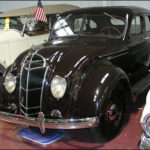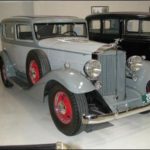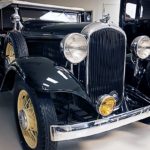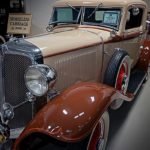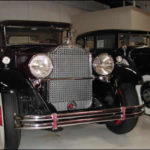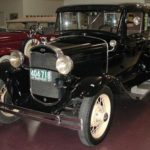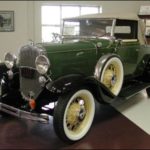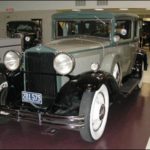Author Archives for adamgillrie
The depression was hardly the right time for anything startlingly different, yet this “car of the future” should have been a sales smash. Ironically, it almost was. Everybody thought it was great, except the buying public. Although years ahead of its time, its extreme styling hurt sales of the Airflow.
Following the most modern concepts of automotive and aviation design, Airflow bodies were constructed around a cage-like steel girder network, to which the body panels were welded. The body and chassis were one integral unit, making the Airflow the forerunner of today’s unit body construction.
The unit body was so strong, that in a widely reported publicity stunt, an Airflow was driven off a 100 foot cliff, bounced down the cliff face, landed on all four wheels, then promptly driven off under its own power.
The 1933 Packard was a limited production car. Our Country was in the midst of the Great Depression, and few people could afford a Packard. As a result, only a handful of this model were built and very few still remain. This is unfortunate because the traditional Packard hood and grille, coupled with sculptured body styling, makes the 1933 Packard one of the most beautiful cars of all time.
This car and all of its components were completely disassembled, renewed or carefully rebuilt to like-new condition. The car was then painstakingly reassembled.
Click Here for Audio Story
The Plymouth PB Model for 1932 was the last of the four cylinder Plymouths until the compact Plymouth Horizon came on the scene in 1971. The 1932 PB Four, with its 196 cubic inch displacement, 65 horsepower engine, was Plymouth's zenith four cylinder car. It is undoubtedly the "most collectable" of the four cylinder Plymouths today.
Wire wheels were standard on the Sport Roadster, as were twin fender mounted spare tires. Free standing chrome headlamps and a rakish low silhouette added much to the attractive looks of the car.
There is an interesting story concerning the 1932 PB Model Plymouth. It is said that Walter P. Chrysler was so proud and so convinced of the superiority of his competitive entry in the low price field that he climbed into the driver's seat of a Plymouth and set off for the Ford Headquarters in Dearborn, Michigan. Henry and Edsel Ford politely went along when Mr. Chrysler took them for a demonstration ride, then surprised when he presented them with the keys to the car and took a taxi home.
Click Here for Audio Story
The 1932 LaSalle has often been described as the most unique and handsome car General Motors ever produced. The gently flowing curves of the body and the overall elegance of this vehicle create a "rolling sculpture." Production was limited, and the LaSalle convertible quickly became the favorite car of prominent sports figures and Hollywood stars. A golf bag door can be found in the left rear quarter. The cream white and blue finish are the original colors.
This Pristine 1932 LaSalle is the premier car of only a handful still in existence. Click Here for Audio Story
The Second Series C1 six cylinder for 1932 was extensively updated. Styling changes included new oval instrument board, new dual split type windshield, dual cowl ventilators, wire wheels with dual side mounts.
Standard equipment included Delco Remy ignition, hydraulic brakes, flexible floating power, double drop frame, freewheeling, hydraulic shock absorbers, and on this car...overdrive transmission.
This 100 point 1932 Chrysler C1 six rumble seat coupe is probably the finest example of this beautiful model in existence. The odometer registers 30,000 miles. The car has undergone countless hours of professional body-off-frame restoration.
Click Here for Audio Story
The Rumble Seat ... The six wire wheels with wide white wall tires ... The Packard trunk with matching luggage ... The throaty rumble of the powerful straight eight engine ... All combined to make the Packard Sport Coupe a favorite with the younger generation of the 1930's.
One of the greatest names in car building in the United States, Packard stood for fine engineering, long life, great sport and luxury cars, early racing success and technical innovation.
Clearly identified by its yoke-shaped radiator and fluted hood, Packard projected an aura of prestige and excellence (especially in the years between the two wars) that was unmatched by any other make in North America. In fact, the car's beauty, dependability and quality often resulted in the Packard name being compared with England's Rolls Royce.
This 1931 Packard has but 55,000 miles on the odometer. It has obviously been carefully maintained. Its history can be traced back to the day, over seventy years ago, that its proud owner took delivery from the showroom floor.
Click Here for Audio Story
After building millions of Model T's, Henry Ford shut down the Ford Motor Company in 1928 in order to retool for the all new and much heralded Model A. There was much excitement and anticipation. Everybody wanted to see the "new Ford." The Model A was an uncomplicated four cylinder, inexpensive machine...easy to own...easy to repair. From 1929 through 1931, it was America's number one seller.
The Chevrolet was a car built for a purpose. It was the vehicle by which William C. Durant intended to regain control of General Motors, the corporation he had founded in 1908 and which he lost to the bankers in 1910.
Specifications:
Overhead Valve Six
Cast Iron Block
Bore and Stroke: 3 5/16 X 3 3/4
194 Cubic Inch Displacement
50 Brake Horsepower
Three Main Bearings
Solid Valve Lifters
Carter Carburetor
In the early years, Ford outsold Chevrolet by as much as 8 to 1; but by 1931, Chevrolet had 6 cylinders, two more than Ford. That year Chevrolet captured the sales lead for the first time. The "Cast Iron Wonder" had arrived. Sometimes known as the "Stove Bolt Six." Chevrolet's sturdy overhead valve engine would endure into the early Fifties.
This beautiful rumble seat convertible, with its wire wheels and dual side mounts, was formerly in the Dykstra collection, Zeeland, Michigan
Click Here for Audio Story
The Hupp Motor Company was one of the many independents during the early years of the automobile. Hupp built fine cars beginning in 1909, and the company was highly successful during its early years. But later, strong competition came along, particularly from Buick, Olds, and Chrysler..competition that, coupled with the effects of the Depression of the 1930's was just too great. Like other independents, the Hupp Motor Company was forced to cease production. The last Hupmobile was built in 1939.
Features of this Hupmobile Model C Victoria include: 100 HP straight 8 engine, balanced crankshaft and flywheel, "steeldraulic brakes," ventilated windshield, and "custom Coachwork by Murray Body Company." The Victoria was sometimes referred to as a "Doctor's Car."
Click Here for Audio Story
